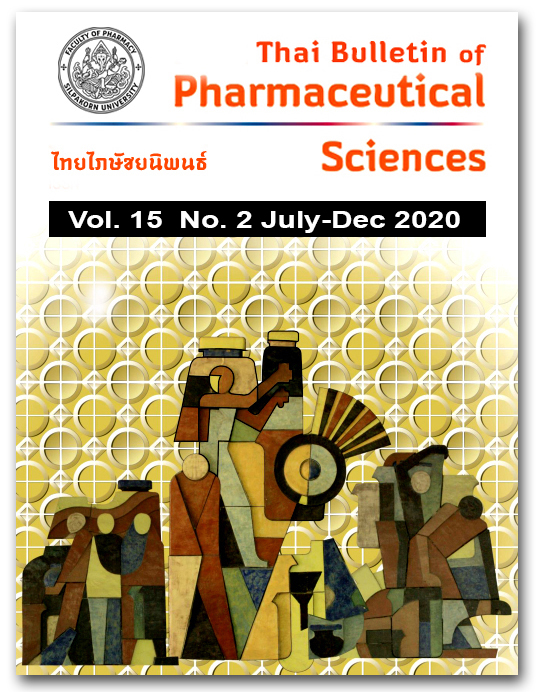CLINICAL FACTOR RELATED TO INTERNATIONAL NORMALIZED RATIO CHANGES IN WARFARIN USERS WHO UNDERWENT HEART VALVE REPLACEMENT AT WARFARIN CLINIC OF PHRAMONGKUTKLAO HOSPITAL
DOI:
https://doi.org/10.69598/tbps.15.2.73-79Keywords:
warfarin, factors, prosthetic valve, international normalized ratio (INR)Abstract
Warfarin is oral anticoagulant that has been used for prevention of systemic thromboembolism in valve replacement patients. There are many factors that can change the international normalized ratio (INR) in warfarin users. This study aimed to determine the influence of factors that related to the target range of INR among warfarin users who underwent heart valve replacement. This study is a retrospective study. The data were collected in patients who underwent valve replacement in warfarin clinic, Phramongkutklao Hospital, Thailand from January 2007 to December 2015. Demographic data including gender, age, type of prosthetic valve, co-morbidities, other medications used with warfarin, herbs or dietary supplements used with warfarin, laboratory data, warfarin initial dosing regimen and INR value were collected. The demographic data and the risk factors were analyzed via descriptive statistics and Fisher's exact test consecutively by using R-program. One hundred and nineteen patients were included. Sixty-four cases were male (53.78%) and mean (±SD) age was 55.09±14.78 years old. The mean (±SD) of body weight was 61.48±13.97 kilograms. Of those, 96 cases (80.67%) had mechanical valve replacement. Only sixteen of warfarin users (13.45%) had INR values with in target range. The results of the present study showed that drug interaction was one of the important factors that was associated with out-of-range INR target (OR 10.17, 95%CI 0.59-175.77) (p=0.051). Drug interaction including drug-drug, drug-herbs and drug-dietary supplement interaction were concerned in patients who received warfarin underwent heart valve replacement.
References
Ansell J, Hirsh J, Hylek E, Jacobson A, Crowther M, Palareti G. Pharmacology and management of the vitamin K antagonists: American College of Chest Physicians Evidence-Based Clinical Practice Guidelines (8th Edition. Chest. 2008;133(6 Suppl):160S-98S.
Ozkan J. ESC Clinical Practice Guidelines on the Management of Valvular Heart Disease-2017 Update. Eur Heart J. 2017;38:2697-8.
Holford NHG. Clinical Pharmacokinetics and Pharmacodynamics of Warfarin: understanding the dose-effect relationship. Clin Pharmacokinet. 1986;11(6):483-504.
Suwanawiboon B, Kongtim P, Chinthammitr Y, Ruchutrakool T, Wanachiwanawin W. The efficacy of 3-mg warfarin initiating dose in adult Thai patients, who required long-term anticoagulant therapy. J Med Assoc Thai. 2011;94(2 Suppl 1):S225-31.
Uygungul E, Ayrik C, Narci H, Erdogan S, Toker I, Demir F, et al. Determining risk factors of bleeding in patients on warfarin treatment. Adv Hematol. 2014;2014:369084.
Wigle P, Hein B, Bloomfield HE, Tubb M, Doherty M. Updated guidelines on outpatient anticoagulation. Am Fam Physician. 2013;87(8):556-66.
Delaney JA, Opatrny L, Brophy JM, Suissa S. Drug-drug interactions between antithrombotic medications and the risk of gastrointestinal bleeding. Can Med Assoc J. 2007; 177(4):347-51.
Abdel-Aziz MI, Ali MA, Hassan AK, Elfaham TH. Factors influencing warfarin response in hospitalized patients. Saudi Pharm J. 2015;23:642-9.
Al-Momany NH, Makahleh ZM, Al-Omari NA, Al-Sarayreh HA, Momani RO. Analysis of factors that interrupt with INR control in the first anticoagulation clinic monitoring Jordanian patients. Clin Appl Thromb Hemost. 2019;25: 1076029619870252.
Bal U, Aydinalp A, Yilmaz K, Ozcalik E, Hasirci S, Atar I, et al. The effects of a low international normalized ratio on thromboembolic and bleeding complications in patients with mechanical mitral valve replacement. J Cardiothorac Surg. 2014;9:79.
Gaikwad T, Ghosh K, Shetty S. VKORC1 and CYP2C9 genotype distribution in Asian countries. Thromb Res. 2014;134:537-44.
Wattanachai N, Kaewmoongkun S, Pussadhamma B, Makarawate P, Wongvipaporn C, Kiatchoosakun S, et al. The impact of non-genetic and genetic factors on a stable warfarin dose in Thai patients. Eur J Clin Pharmacol. 2017;73(8):973-80.
Hirsh J, Dalen JE, Anderson DR, Poller L, Bussey H, Ansell J, et al. Oral anticoagulants: mechanism of action, clinical effectiveness, and optimal therapeutic range. Chest. 2001;119(1 Suppl):8S-21S.
Holm J, Lindh JD, Andersson ML, Mannheimer B. The effect of amiodarone on warfarin anticoagulation: a register-based nationwide cohort study involving the Swedish population. J Thromb Haemost. 2017;15:446-53.
Busenbark LA, Cushnie SA. Effect of Graves' disease and methimazole on warfarin anticoagulation. Ann Pharmacother. 2006;40(6):1200-3.
Self TH, Owens RE, Sakaan SA, Wallace JL, Sands CW, Howard-Thompson A. Effect of diseases on response to vitamin K antagonists. Curr Med Res Opin. 2016;32(4):613-20.
Bungard TJ, Yakiwchuk E, Foisy M, Brocklebank C. Drug interactions involving warfarin: Practice tool and practical management tips. Can Pharm J. 2011;144(1):21-5.
Chua YT, Ang XL, Zhong XM, Khoo KS. Interaction between warfarin and Chinese herbal medicines. Singapore Med J. 2015;56(1):11-8.
Juurlink DN. Drug interactions with warfarin: what clinicians need to know. Can Med Assoc J. 2007;177(4):369-71.
Choi KH, Kim AJ, Son IJ, Kim KH, Kim KB, Ahn H, et al. Risk factors of drug interaction between warfarin and nonsteroidal anti-inflammatory drugs in practical setting. J Korean Med Sci. 2010;25(3):337-341.
Wada K, Kojima E, Takada M, Shibakawa M. Interaction of Warfarin and Rifampicin on Medical Report. Jpn J Pharm Health Care Sci. 2002;28(1):85-90.
Downloads
Published
How to Cite
Issue
Section
License
All articles published and information contained in this journal such as text, graphics, logos and images is copyrighted by and proprietary to the Thai Bulletin of Pharmaceutical Sciences, and may not be reproduced in whole or in part by persons, organizations, or corporations other than the Thai Bulletin of Pharmaceutical Sciences and the authors without prior written permission.



